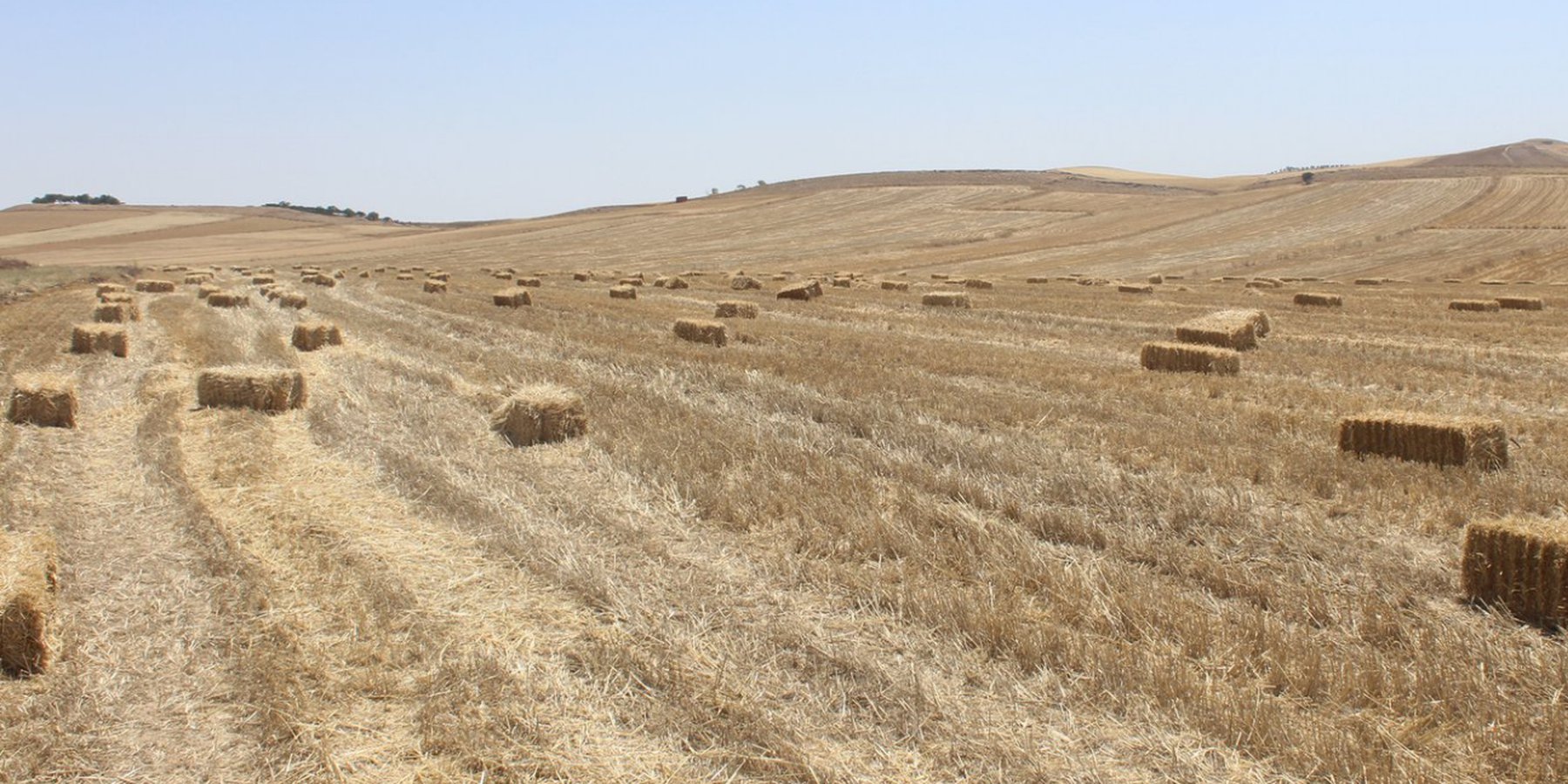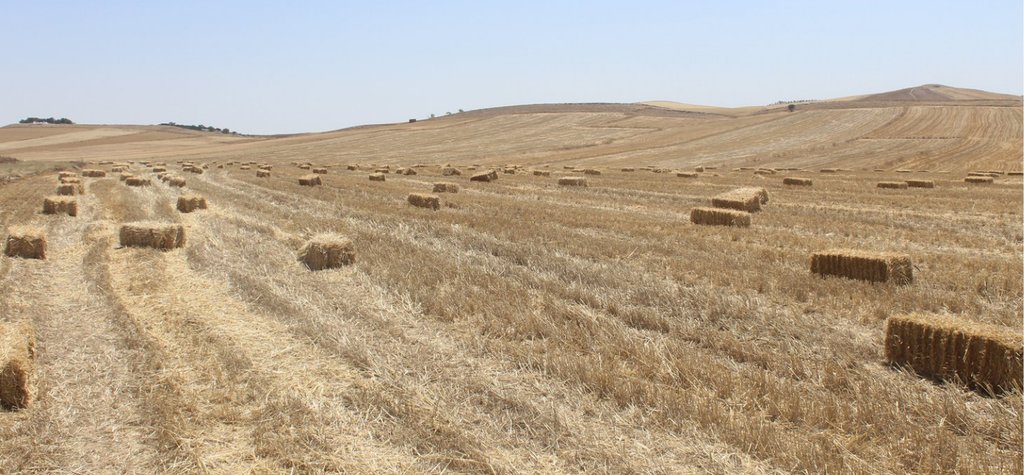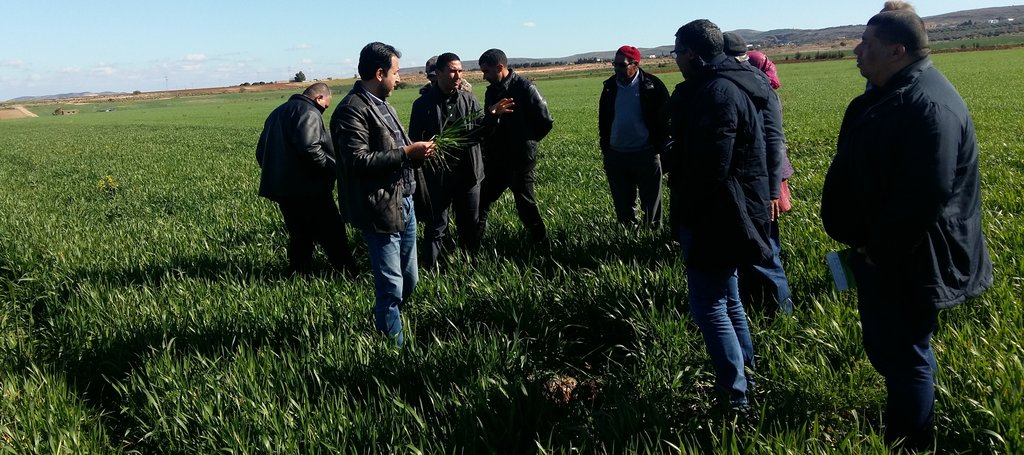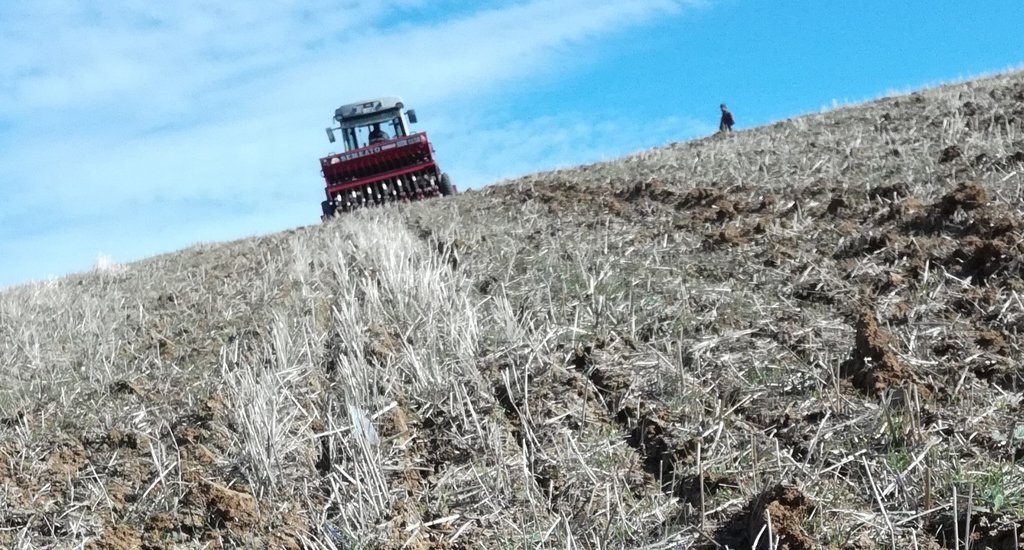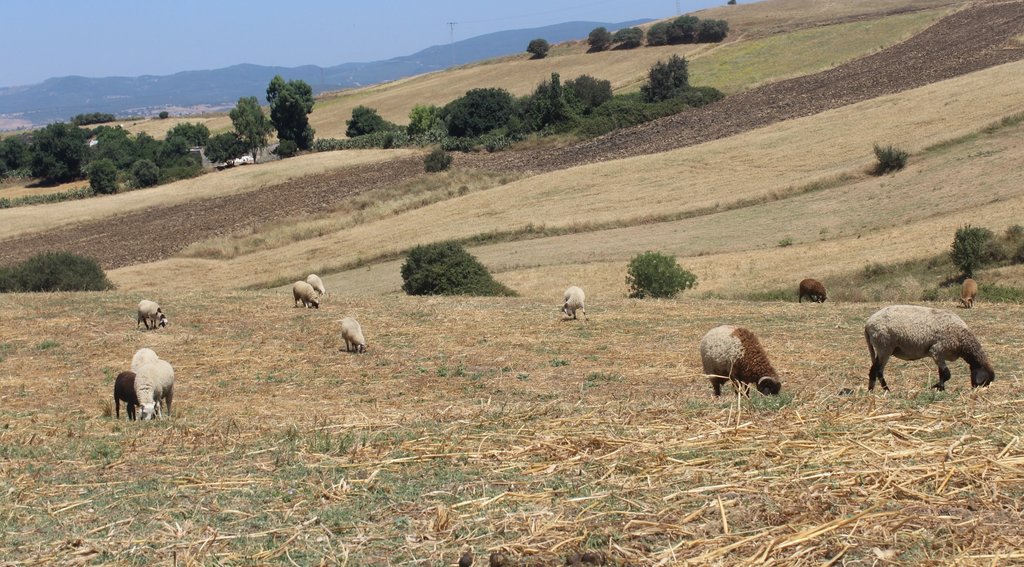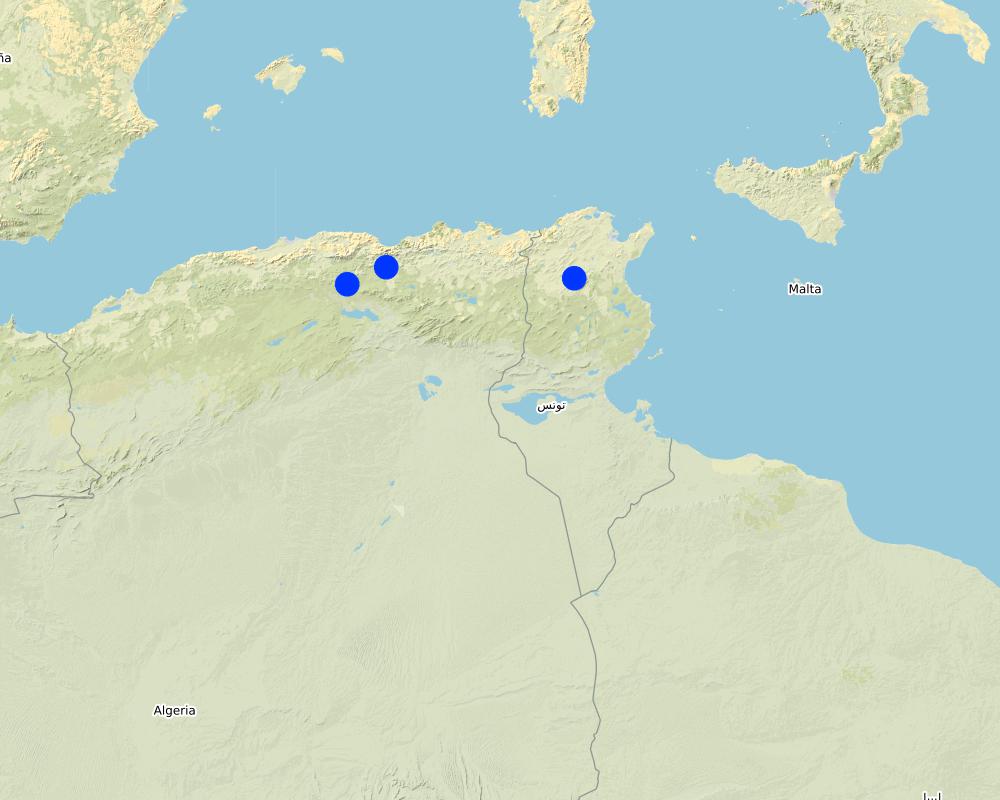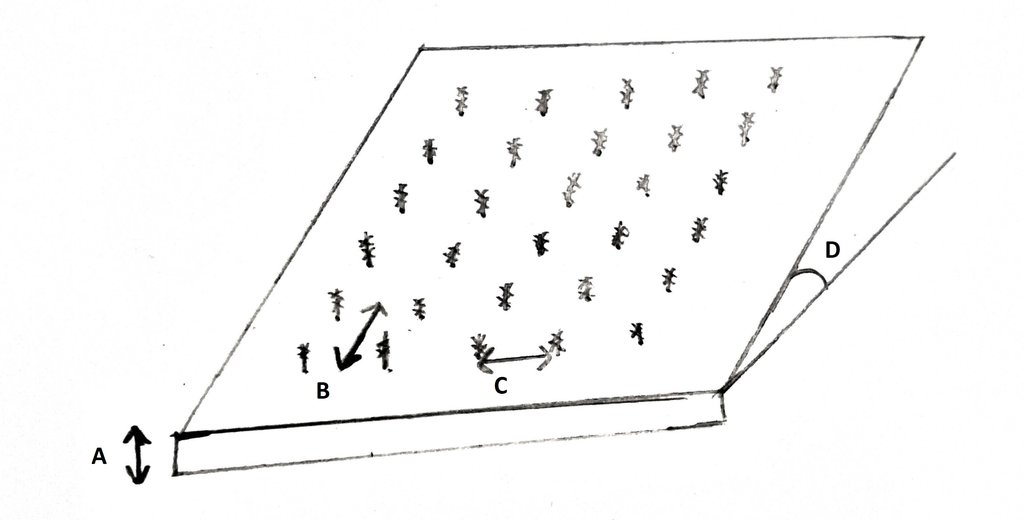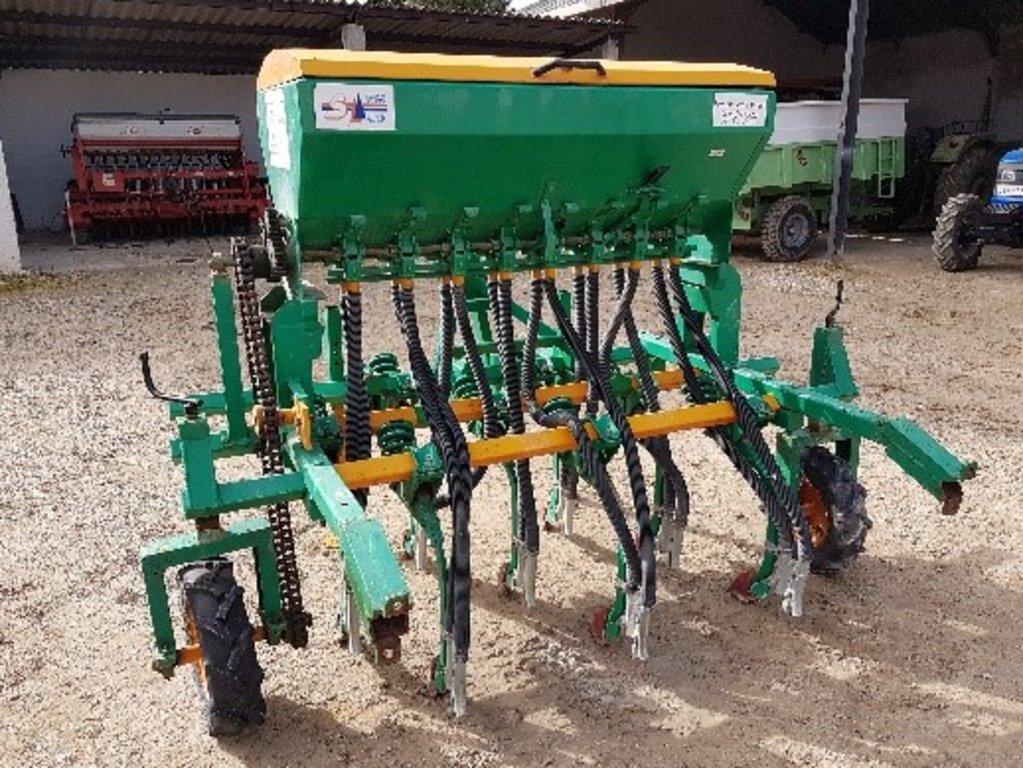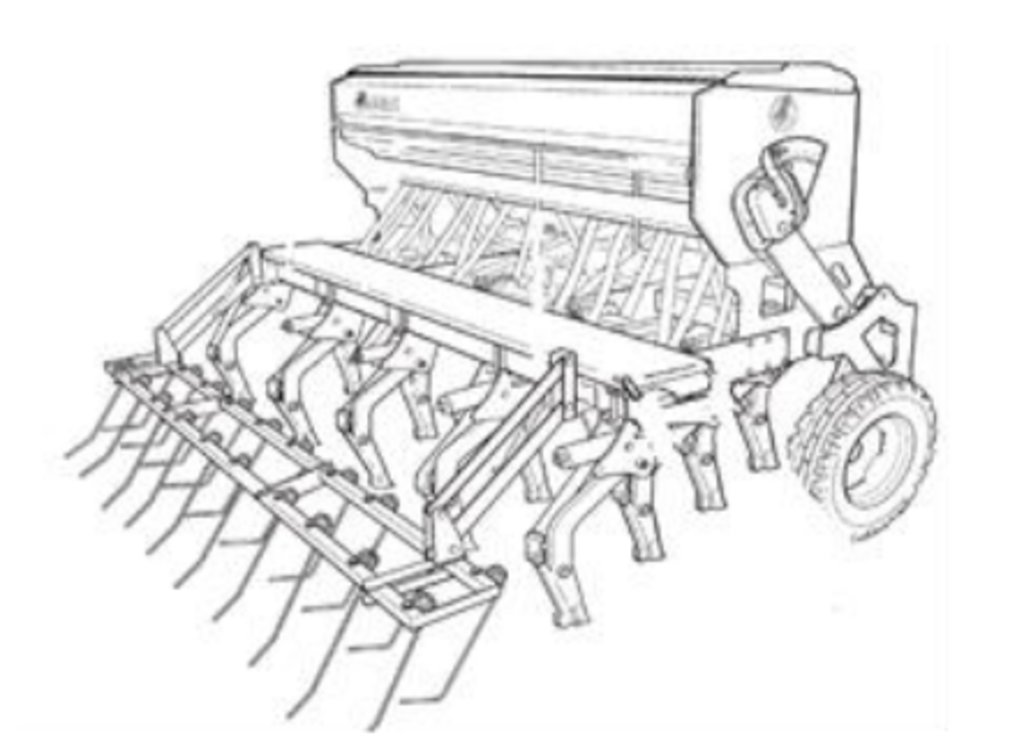Conservation Agriculture in Dryland Mixed Systems [Тунис]
- Шинийг нээх:
- Шинэчлэх:
- Мэдээлэл цуглуулсан: Joren Verbist
- Редактор: –
- Хянагч: Rima Mekdaschi Studer
technologies_5819 - Тунис
Бүлгүүдийг үзэх
Бүгдийг харуулах Бүгдийг хаах1. Ерөнхий мэдээлэл
1.2 Технологийг үнэлэх, баримтжуулах ажилд хамаарах мэдээлэл өгсөн хүмүүс, байгууллагуудын холбоо барих мэдээлэл
Мэдээлэл өгсөн хүн (с)
Senior Livestock Scientist:
Rekik Mourad
International Center of Agriculture Research in the Dry Areas (ICARDA)
Тунис
Agronomist:
M'hamed Cheikh Hatem
National Institute of Agricultural Research of Tunisia (INRAT)
Тунис
Scaling Specialist:
Idoudi Zied
International Center of Agriculture Research in the Dry Areas (ICARDA)
Тунис
Технологи баримтжуулах/үнэлэх ажилд дэмжлэг үзүүлсэн төслийн нэр (шаардлагатай бол)
ICARDA Institutional Knowledge Management InitiativeТехнологи баримтжуулах/үнэлэх ажилд дэмжлэг үзүүлсэн байгууллага(ууд)-ын нэр (шаардлагатай бол)
International Center for Agricultural Research in the Dry Areas (ICARDA) - Ливан1.3 WOCAT-аар баримтжуулсан өгөгдлийг ашиглахтай холбоотой нөхцөл
Эмхэтгэгч болон гол мэдээлэгч хүн(хүмүүс) WOCAT аргачлалаар баримтжуулсан мэдээллийг ашиглахтай холбоотой нөхцлийг хүлээн зөвшөөрсөн.
Тийм
1.4 Технологи тогтвортой гэдгийг баталгаажуулах
Энэ технологи азрын доройтлыг бууруулахад нөлөө үзүүлэхгүй тул газрын тогтвортой менежментийн технологи болж чадахгүй юу?
Үгүй
2. ГТМ Технологийн тодорхойлолт
2.1 Технологийн товч тодорхойлолт
Технологийн тодорхойлолт:
Conservation Agriculture (CA) is a "ready-to-scale concept" in agriculture that allows a sustainable agricultural production and mitigation of climate change. The documented CA focuses on a dryland mixed system, including a biennial rotation of legume and cereals with integrated livestock management. CA has positive benefits on soil health and significantly reduces the needed inputs (e.g. fuel, labour) and workload for farmers.
2.2 Технологийн дэлгэрэнгүй тайлбар
Тодорхойлолт:
Land degradation leading to desertification is an increasingly important problem in the dry land regions of the globe. This does not only affect the bio-physical aspects such as carbon storage, but also the lives of local land users. Land degradation is often initiated by the lack of vegetation cover as is often a consequence of overgrazing and over-ploughing (i.e mismanagement). Furthermore, climate change leads to droughts, intensified rainfall events, increased temperature, and more extreme weather events. These compromised climatic conditions enhance land degradation. This leads to less fertile soils, reducing yields and consequently deteriorates the income and lives of local farmers. Taking the consequence and scale of degradation into account, natural resource conservation interventions are urgently required.
As the lack of soil cover is an, if not the, essential initiating factor in the desertification process, it should be maximally addressed. In the light of this, CA has been developed, based on three leading principles: i) minimizing soil disturbances or no-tillage, ii) maintaining a permanent soil cover with mulch, and iii) adequate crop rotations. Overall, the three principles prevent land degradation and can also rehabilitate the land. This is because soil organic matter is maintained in/on the soil and the erosive power of raindrops are broken by the soil cover. Therefore, CA aims for more sustainable resource use (land and water use) and to optimize climate-resilient and integrated crop-livestock systems to sustainably intensify production in fragile dry areas.
Tunisia is a country that experiences the previously described pattern and results of desertification and where smallholder farmers are largely dependent on livestock for income generation. However, the livestock competes with the concept of CA as plant residues (stubble) are normally grazed by the livestock. Conservation agriculture propagates no or minimum soil disturbance/ tillage. However, the purchase of a zero-tillage seeder machine appears to be a bottleneck due to high costs since they are hardly produced locally. Nevertheless, there are farmers in the semi -arid areas of Tunisia, who adopted the technology and experience significant benefits such as increased soil fertility and over time increasing yields. In addition, as erosion rates are high in this rainfed area of 300 to 600 mm annual precipitation, a well-covered soil will reduce runoff and loss of top soil. Since ploughing is restricted, the workload and the demanded fuel is reduced, resulting in decreased costs and labour with respect to the conventional practices. Furthermore, integrated crop-livestock is practiced by limiting livestock to graze only the freshly harvested fields while producing manure to enhance soil health (organic fertilization and increase in soil organic matter).
Additionally, according to the third principle of CA, legumes were introduced in the agricultural system (crop rotation), besides the conventional cereal (e.g. durum wheat or barley). Specifically, faba bean is promising, as it has nitrogen fixing effects, enhancing soil health, and increasing and diversifying farm income. Vetch and other forage mixtures have also been successfully introduced to provide farmers with nutritious feed for livestock within the CA concept. In irrigated areas (e.g. parts in Algeria), the practice of CA has an additional benefit as it increases the irrigation water use efficiency due to less evaporation and better infiltration.
The previous agro-pastoral farming practices changed under CA to an integrated crop-livestock system where soil cover is permanent. This mixed system consist of firstly weed control. Secondly, zero-tillage seeding is done directly into the soil even if covered with e.g. mulch/stubble. Faba bean and/or wheat are seeded and rotated yearly. This is beneficial as legumes fix nitrogen in the soil, lowering the amount of nitrogenous fertilizer needed. Thirdly, required fertilizers (for wheat additional nitrogenous fertilizer) is applied with a spreader. Fourthly, herbicides, pesticides, insecticides and fungicides are applied with a sprayer for disease control. Fifthly, the field is harvested with a combine. The stubble is then partly grazed by the sheep and goats until there remains a 1-2 cm residue layer i.e. mulch. For one hectare this accounts for a thirty day grazing period for thirty goats or sheep. This results in an integrated Crop-Livestock system under CA (CLCA), as the stubble provides feed for livestock while the livestock provides the soil with manure.
The land users that have adopted CA have indicated that they extremely appreciate the reduction in work, also the cost of labour and fuel, etc. In addition, they saw increased yields due to improved soil health. However, this beneficial impact could only be observed in the long-term since yields take time to increase, which can be considered as a weakness as the small holder farmer tends to prioritize short term profits. Another weakness is that the livestock is constrained since residues ought to remain on the field.
In conclusion, even though there are bottlenecks, the technology of conservation agriculture is a solution to combat desertification while improving the lives of local land users through the process.
Information and data presented is partly made available through the project “Use of conservation agriculture in crop-livestock systems (CLCA) in the drylands for enhanced water use efficiency, soil fertility and productivity in NEN and LAC countries” funded by the International Fund for Agricultural Development (IFAD), managed by the International Center for Agricultural Research in the Dry Areas (ICARDA) and implemented in Tunisia by the National Agricultural Research Institute (INRAT).
2.3 Технологийн гэрэл зураг
2.5 Энэ үнэлгээнд хамрагдсан технологийг хэрэгжүүлсэн улс орон / бүс нутаг / байршил
Улс :
Тунис
Улс/аймаг/сум:
Algeria: M'Sila and Setif; Tunisia: Siliana
Технологи өргөн дэлгэрсэн эсхийг тодорхойл:
- газар дээр жигд тархсан
Хэрэв талбайн хэмжээ тодорхойгүй бол талбайн хэмжээг ойролцоогоор тодорхойлно уу.
- 100-1,000 км2
Технологи(иуд) нэвтрүүлсэн талбай байнгын хамгаалалттай газар нутагт байрладаг уу?
Үгүй
Тайлбар:
The land under CA in Tunisia and Algeria is 14 000ha and 5600 ha, respectively. Most of the sites (approximately 70%) are thus located in Tunisia. The regions pinned in the map represent the sites that match the documentation.
Map
×2.6 Хэрэгжих огноо
Хэрэгжүүлсэн он:
1999
2.7 Технологийн танилцуулга
Технологийг хэрхэн нэвтрүүлснийг тодорхойл:
- Туршилт/судалгааны үр дүн
- Гадны төсөл/хөтөлбөрийн дэмжлэгтэйгээр
3. ГТМ технологийн ангилал
3.1 Технологийн үндсэн зорилго (д)
- Үйлдвэрлэлийг сайжруулах
- Газрын доройтлыг бууруулах, сэргийлэх, нөхөн сэргээх
- Уур амьсгалын өөрчлөлт/ эрс тэс байдал болон түүний нөлөөлөлд дасан зохицох
- Үр ашигтай эдийн засгийн нөлөөг бий болгох
3.2 Технологи хэвтрүүлсэн газрын одоогийн газар ашиглалтын хэлбэр(д)
Нэг газр нутгийн хэмжээнд хэрэгжих холимог газар ашиглалт:
Тийм
Газар ашиглалтын холимог тогтолцоог (тарилан/бэлчээр/ой мод) тодорхойл:
- Агро-бэлчээр (тарилан-мал аж ахуйн хослуулсан тогтолцоог хамруулан ойлгоно)

Тариалангийн газар
- Нэг наст үр тариа
Тариалан - Таримлыг тодорхойлно уу:
- үр тариа - улаан буудай (өвлийн)
- буурцагт ургамал - шош
- Faba bean, vetch
Тариалалтын тогтолцоо:
Улаанбуудай эсвэл тэжээлийн ургамал/бэлчээр ээлжилсэн
Нэг жил дэх ургамал ургах улирлын тоо:
- 1
Сөөлжлөн тариалалт хийгддэг үү?
Үгүй
Таримлыг ээлжлэн тариалдаг уу?
Тийм
Хэрэв тийм бол, тодруулна уу:
Wheat is rotated with other crops (see technicality) such as faba bean or forage crops like vetch.

Бэлчээрийн газар
Эрчимжсэн бэлчээр / тэжээл үйлдвэрлэл:
- Хадлан буюу бэлчээрт ашиглагдахгүй талбай
- livestock allowed to graze only the freshly harvested fields
амьтдын төрөл зүйл:
- ямаа
- хонь
Тариалан-мал аж ахуйн нэгдсэн менежмент хэрэгждэг үү?
Тийм
Хэрэв тийм бол, тодруулна уу:
Crop residues remain on the field. This is allowed for limited grazing by the livestock after harvest (between april and july). The 30-30 rule states that is allowed for a 30 sized flock (sheep or goats) to graze 1 ha for 30 days. Logically, bigger flock means less days and vice versa. While the flock grazes the land it provides the soil with manure. Vetch is cut and carried to feed the livestock.
Бүтээгдэхүүн ба үйлчилгээ:
- мах
- сүү
Төрөл зүйл:
ямаа
Төрөл зүйл:
хонь
3.3 Технологи хэрэгжүүлснээс газар ашиглалтад өөрчлөлт гарсан уу?
Технологи хэрэгжүүлснээс газар ашиглалтад өөрчлөлт гарсан уу?
- Тийм (Технологи хэрэгжүүлэхээс өмнөх үеийн газар ашиглалтын талаархи асуулгыг бөглөнө үү)
Нэг газр нутгийн хэмжээнд хэрэгжих холимог газар ашиглалт:
Тийм
Газар ашиглалтын холимог тогтолцоог (тарилан/бэлчээр/ой мод) тодорхойл:
- Агро-бэлчээр (тарилан-мал аж ахуйн хослуулсан тогтолцоог хамруулан ойлгоно)

Тариалангийн газар
- Нэг наст үр тариа
Тариалан - Таримлыг тодорхойлно уу:
- үр тариа - улаан буудай (өвлийн)
Тариалалтын тогтолцоо:
Улаан буудай/арвай/овъеос/цагаан будаа тасралтгүй тариалсан
Сөөлжлөн тариалалт хийгддэг үү?
Үгүй
Таримлыг ээлжлэн тариалдаг уу?
Үгүй

Бэлчээрийн газар
- livestock allowed to graze only the freshly harvested fields
амьтдын төрөл зүйл:
- ямаа
- хонь
Тариалан-мал аж ахуйн нэгдсэн менежмент хэрэгждэг үү?
Тийм
Хэрэв тийм бол, тодруулна уу:
livestock allowed to graze on the cereal stubbles left in the field.
Бүтээгдэхүүн ба үйлчилгээ:
- мах
- сүү
Тайлбар:
The land use has not necessarily changed as in the previous agro-pastoral system, livestock was also allowed to graze the field, providing it with manure. The difference is that under CA the livestock is not allowed to fully graze the land, leaving a soil cover.
3.4 Усан хангамж
Технологи хэрэгжүүлсэн газрын усан хангамж:
- Байгалийн усалгаатай
3.5 Технологи ГТМ-ийн аль бүлэгт хамаарах
- Газар тариалан-мал аж ахуйн нэгдсэн менежмент
- гадаргын/ ургамал бүрхэвч сайжрах
- Хамгийн бага хөрсний эвдрэл
3.6 Технологийг бүрдүүлэх ГТМ арга хэмжээ

Агрономийн арга хэмжээ
- А1: Ургамал/ хөрсөн бүрхэвч
- А3: Хөрсний гадаргыг сайжруулах
- А6: Хагд өвсний менежмент
А3: Хөрс боловсруулах тогтолцоог ялгана уу:
А 3.1: Тэг боловсруулалт
А6: Хагд өвсний менежментийг тодорхойлно уу:
А 6.4: өнжөөх

Менежментийн арга хэмжээ
- М2: Ашиглалтын менежмент/эрчимийг өөрчлөх
Тайлбар:
The residues are partly retained and partly grazed.
3.7 Технологийн шийдвэрлэсэн газрын доройтлын үндсэн төрлүүд

Хөрс усаар эвдрэх
- Wt: Хөрсний гадаргын угаагдал
- Wg: Гуу жалгын элэгдэл

Хөрс салхиар эвдрэх
- Et: Хөрсний гадаргын зөөгдөл

Хөрсний химийн доройтол
- Cn: Үржил шим болон органик агууламж буурах (элэгдлийн шалтгаангүй)

Хөрсний физик доройтол
- Pk: Гадаргуу дээр өгөршлийн давхарга үүсэх

Биологийн доройтол
- Bc: Ургамлан нөмрөг багасах
- Bq: Хэмжээ/ Биомасс буурах
- Bl: Хөрсөн дэхь амьдрал алдагдах
- Bp: Хортон шавьж/өвчлөл ихсэх, махчид цөөрөх

Усны доройтол
- Ha: Хуурайшилт
3.8 Газрын доройтлоос урьдчилан сэргийлэх, сааруулах ба нөхөн сэргээх
Газрын доройтолтой холбоотойгоор Технологи ямар зорилго тавьсан болохыг тодорхойл:
- Газрын доройтлоос урьдчилан сэргийлэх
- Хүчтэй доройтсон газрыг нөхөн сэргээх/ сайжруулах
Тайлбар:
The technology of CA prevents land degradation as the soil cover prevents erosion because the cover breaks the erosive power of rainfall and wind. Also, CA has the ability to rehabilitate as the content (like organic matter and carbon) of the soil cover (e.g. mulch/stubble) remains in the soil eventually improving the soil quality.
4. Техникийн нөхцөл, хэрэгжилтийн үйл ажиллагаа, материал ба зардал
4.1 Технологийн техникийн зураг
Техник тодорхойлолт (техник зурагтай уялдана):
The row interspace (C) for wheat and faba bean is respectively 17 centimeter and 35 centimeter. The density [plants per square meter] for wheat and faba bean is, respectively, 300-400 and 25. The spacing between crops in the row (B) for wheat and faba bean is, respectively, 1.5-2 centimeter and 11 centimeter. The slopes of the fields (D) vary between 3% and 10%.
For the livestock integration with CA, a flock of thirty (goats or sheep) may graze 1 hectare of stubble for a period of thirty days. This yields optimal trade-off between livestock and soil cover. As soil cover a 1-2 cm residue layer remains (A).
Please note that these values may vary with respect to different terrain, species of plants, flock size, and fertilizer application. For example if a flock contain more sheep or goats, it logically results in less grazing days.
Зохиогч:
Joren Verbist
Он, сар, өдөр:
22/12/2020
Техник тодорхойлолт (техник зурагтай уялдана):
The local Tunisian zero-tillage seeder is named Sajir. This machine has better results than imported machines in terms of adjustable and homogeneous sowing depth, high germination rate and similar yield. The design is still changing to the recent and ongoing modifications (e.g. designing and manufacturing a local tine) to be better suitable to Tunisian soil context.
Зохиогч:
Mohamed Jadlaoui
Он, сар, өдөр:
01/01/2020
Техник тодорхойлолт (техник зурагтай уялдана):
"Boudour" is a zero-tillage seeder machine used in Algeria.
Its technicality: The loading capacity is 150 kilogram of seeds and 150 kilograms for fertilizer.
The depth can be adjusted and is between 0 and 8 cm. The overall width is 2.8 meter whereas the seed row spacing is 18 centimetres.
The loading height is 154 centimetres.
It is suitable for a 65-76 horsepower tractor.
Зохиогч:
SOLA
Он, сар, өдөр:
01/04/2020
4.2 Материал болон зардалд хамаарах ерөнхий мэдээлэл
Үнэ өртөг, оруулсан хувь нэмрийг хэрхэн тооцсоныг тодорхойл:
- Технологийн нэгж тус бүр
Хэмжээ ба нэгж талбайг тодорхойл:
1 hectare
Үнэ өртөгийг тооцоход ашигласан мөнгөн нэгж:
- Ам.доллар
Хөлсний ажилчны нэг өрдийн ажлын хөлсийг тодорхойл:
5.3
4.3 Байгуулах үйл ажиллагаа
| Үйл ажиллагаа | Хугацаа (улирал) | |
|---|---|---|
| 1. | Purchase Zero-Tillage Seeder |
4.4 Байгуулалтад шаардагдах зардал ба материал
| Хөрөнгө оруулалтыг дурьдана уу | Хэмжих нэгж | Тоо хэмжээ | Нэгжийн өртөг | Материал бүрийн нийт өртөг | % газар ашиглачаас гарсан зардал | |
|---|---|---|---|---|---|---|
| Тоног төхөөрөмж | Zero-Tillage Seeder | piece | 1.0 | 20000.0 | 20000.0 | |
| Технологи бий болгох нийт үнэ өртөг | 20000.0 | |||||
| Технологи бий болгох нийт үнэ өртөг, ам.доллар | 20000.0 | |||||
Тайлбар:
The Zero-Tillage-Seeder can be bought as a community. This would lower the effective cost per farmer. Also, it is possible to hire Zero-Tillage Seeder.
4.5 Засвар үйлчилгээ / давтагдах үйл ажиллагаа
| Үйл ажиллагаа | Хугацаа/ давтамж | |
|---|---|---|
| 1. | Weeding (Total weed control) | Year 1 Early-October |
| 2. | Seeding Faba Bean | Year 1 Mid-October |
| 3. | Apply Baseline Fertilization | Year 1 Mid-October |
| 4. | Apply Herbicide | Year 1 Mid-October |
| 5. | Apply Fungicide and Insecticide | Year 1 March-Early April |
| 6. | Limited Grazing/Harvesting | Year 1 Late-April/May |
| 7. | Weeding (Total weed control) | Year 2 Early-November |
| 8. | Seeding Wheat | Year 2 Mid-November |
| 9. | Apply Baseline Fertilization | Year 2 Mid-November |
| 10. | Apply Nitrogenous Fertilization | Year 2 December-January-February |
| 11. | Apply Herbicide | Year 2 December |
| 12. | Apply Fungicide | Year 2 March-April |
| 13. | Limited Grazing/Harvesting | Year 2 Late-June/Early-July |
4.6 Засвар үйлчилгээ / урсгал үйл ажиллагаанд шаардагдах зардал ба материал (жилээр)
| Хөрөнгө оруулалтыг дурьдана уу | Хэмжих нэгж | Тоо хэмжээ | Нэгжийн өртөг | Материал бүрийн нийт өртөг | % газар ашиглачаас гарсан зардал | |
|---|---|---|---|---|---|---|
| Хөдөлмөр эрхлэлт | Weeding | Person-hour | 1.0 | 100.0 | ||
| Хөдөлмөр эрхлэлт | Seeding | Person-hour | 2.0 | 100.0 | ||
| Хөдөлмөр эрхлэлт | Fertilizer Application | Person-hour | 0.5 | 100.0 | ||
| Хөдөлмөр эрхлэлт | Harvesting | Person-hour | 2.0 | 100.0 | ||
| Тоног төхөөрөмж | The Zero-Tillage Seeder (hiring cost) | Machine-hour | 2.0 | 16.5 | 33.0 | 100.0 |
| Тоног төхөөрөмж | Sprayer (hiring cost for disease control) | Machine-hour | 4.5 | 11.0 | 49.5 | 100.0 |
| Тоног төхөөрөмж | Spreader (hiring costs for nitrogenous fertilizer application) | Machine-hour | 1.5 | 11.0 | 16.5 | 100.0 |
| Тоног төхөөрөмж | Combine (hiring cost for harvesting) | Machine-hour | 2.0 | 47.5 | 95.0 | 100.0 |
| Таримал материал | Seeds Wheat | Kilogram | 160.0 | 0.4 | 64.0 | 100.0 |
| Таримал материал | Seeds Faba Bean | Kilogram | 120.0 | 0.48 | 57.6 | 100.0 |
| Бордоо ба биоцид | Baseline Fertilization | Quintal | 2.5 | 19.9 | 49.75 | 100.0 |
| Бордоо ба биоцид | Nitrogenous Fertilization | Quintal | 3.0 | 15.5 | 46.5 | 100.0 |
| Бордоо ба биоцид | Pesticide (for total weed control) | Liter | 2.0 | 10.0 | 20.0 | 100.0 |
| Бордоо ба биоцид | Herbicide for grassy weeds | Liter | 1.0 | 41.2 | 41.2 | 100.0 |
| Бордоо ба биоцид | Herbicide for broadleaf weeds and sedges | Liter | 2.0 | 29.2 | 58.4 | 100.0 |
| Бордоо ба биоцид | Fungicide | Liter | 1.5 | 40.0 | 60.0 | 100.0 |
| Бордоо ба биоцид | Herbicide for annual and perennial grasses | Liter | 1.25 | 25.5 | 31.88 | 100.0 |
| Бордоо ба биоцид | Insecticide | Liter | 0.1 | 66.8 | 6.68 | 100.0 |
| Бусад | Casual Labour | Person-day | 12.0 | 5.3 | 63.6 | 100.0 |
| Технологийг арчилах тордоход шаардагдах нийт үнэ өртөг | 693.61 | |||||
| Технологи сайжруулах нийт үнэ өртөг, ам.доллар | 693.61 | |||||
Тайлбар:
Assuming a biennial rotation (Legume-Cereal), inputs and costs for the establishment of one hectare under the technology are displayed in the table. The costs for solely faba bean is 332.8 USD per hectare.
4.7 Зардалд нөлөөлж байгаа хамгийн чухал хүчин зүйл
Өртөг зардлыг тодорхойлох гол хүчин зүйлсийг дурьдана уу:
The initial purchase of the zero-tillage machine (20 000 USD) is dominantly affecting the costs of the technology. However, it should be taken into account, that this machine serves the long term. Because the area under description is dominated by small-scale farmers, access to zero-tillage machines is ensured through hiring private entrepreneurs or through the purchase of machines by farmers’ associations rather than individual farmers. Also, it is important to note that the additional costs of conservation agriculture mainly consists of the machine, the weeding control and the seeding of the legumes. Other costs are either similar or reduced with respect to conventional agriculture. For example, conventional agriculture requires three hours of ploughing and 1 hour of sowing. While conservation agriculture only needs half an hour for chemical weeding, 1 hour for sowing and does not require ploughing. This relates to reduced inputs such as fuel.
5. Хүн, байгалийн хүрээлэн буй орчин
5.1 Уур амьсгал
Жилийн нийлбэр хур тундас
- <250 мм
- 251-500 мм
- 501-750 мм
- 751-1,000 мм
- 1,001-1,500 мм
- 1,501-2,000 мм
- 2,001-3,000 мм
- 3,001-4,000 мм
- > 4,000 мм
Агро-уур амьсгалын бүс
- Хагас хуурай
- Хуурай
5.2 Байрзүйн зураг
Дундаж налуу:
- Тэгш (0-2 %)
- Бага зэрэг хэвгий (3-5 %)
- Дунд зэрэг хэвгий (6-10 % )
- Долгиорхог (11-15 %)
- Толгодорхог (16-30 %)
- Эгц налуу (31-60 % )
- Огцом эгц налуу (>60 %)
Гадаргын хэлбэр:
- Тэгш өндөрлөг/тэгш тал
- Зоо, хяр
- Уулын энгэр, хажуу
- Ухаа, гүвээ, дов толгод
- Уулын бэл
- Хөндий, хоолой, нам хотос
Өндөршлийн бүс:
- 0-100 м д.т.д
- 101-500 м д.т.д
- 501-1,000 м д.т.д
- 1,001-1,500 м д.т.д
- 1,501-2,000 м д.т.д
- 2,001-2,500 м д.т.д
- 2,501-3,000 м д.т.д
- 3,001-4,000 м д.т.д
- > 4,000 м д.т.д
Технологи дараах асуудалд хандсан эсэхийг тодорхойл:
- шаардлагагүй
5.3 Хөрс
Хөрсний дундаж зузаан:
- Маш нимгэн (0-20 см)
- Нимгэн (21-50 см)
- Дунд зэрэг зузаан (51-80 см)
- Зузаан (81-120 cм)
- Маш зузаан (>120 cм)
Хөрсний бүтэц (өнгөн хөрс):
- Дунд зэрэг (шавранцар)
Хөрсний бүтэц (>20 см-ээс доош):
- Сийрэг/хөнгөн (элсэрхэг)
- Дунд зэрэг (шавранцар)
Өнгөн хөрсний органик нэгдэл:
- Дунд (1-3 % )
- Бага (<1 % )
Боломжтой бол хөрсний бүрэн тодорхойлолт, боломжит мэдээллийг өгнө үү, жишээ нь хөрсний төрөл, хөрсний урвалын орчин/хүчиллэг байдал, катион солилцох чадавхи, азотын хэмжээ, давсжилт г.м.
The top soil organic matter is relatively high as consequence of conservation agriculture.
5.4 Усны хүртээм ба чанар
Хөрсний усны гүн:
< 5 м
Гадаргын усны хүртээмж:
Муу/огт байхгүй
Усны чанар (цэвэрлээгүй):
Муу чанарын ундны ус (цэвэршүүлэх шаардлагатай)
Усны чанар гэж:
ул хөрсний ус
Усны давсжилт асуудал болдог уу?
Тийм
Энэ газар үер усанд автдаг уу?
Үгүй
5.5 Биологийн төрөл зүйл
Зүйлийн олон янз байдал:
- Бага
Амьдрах орчны олон янз байдал:
- Бага
5.6 Технологи нэвтрүүлсэн газар ашиглагчидын онцлог шинж
Суурьшмал эсвэл нүүдлийн:
- Суурьшмал
Үйлдвэрлэлийн системийн зах зээлийн чиг баримжаа:
- холимог (амьжиргаа ба худалдаанд)
Фермээс гадуурх орлого:
- Нийт орлогын % 10-50 хувь
Чинээлэг байдлыг харьцангуй түвшин:
- Ядуу
- Дундаж
Хувь хүн эсвэл бүлэг:
- Хувь хүн / өрх
- бүлэг / олон нийтийн
Механикжилтын түвшин:
- Механикжсан / мотортой
Хүйс:
- Эмэгтэй
- Эрэгтэй
Газар ашиглагчийн нас:
- Дунд нас
- Ахимаг нас
5.7 Технологи нэвтрүүлэхэд газар ашиглагчийн ашигласан газрын дундаж талбай
- < 0.5 га
- 0.5-1 га
- 1-2 га
- 2-5 га
- 5-15 га
- 15-50 га
- 50-100 га
- 100-500 га
- 500-1,000 га
- 1,000-10,000 га
- > 10,000 га
Энэ нь жижиг, дунд, том оворт тооцогдох уу (орон нутгийн чиг баримжаагаар)?
- Бага-хэмжээний
Тайлбар:
Average size of smallholder farmers that have adopted CA have a farm size of less than ten hectares.
5.8 Газар эзэмшил, газар ашиглах эрх, ус ашиглах эрх
Газар өмчлөл:
- Хувь хүн, тодорхой цол эргэмгүй
- Хувь хүн, цол эргэм бүхий
Газар ашиглах эрх:
- Хувь хүн
Ус ашиглах эрх:
- Нэгдлийн хэлбэрээр (зохион байгуулалттай)
- Хувь хүн
Газар ашиглалтын эрх уламжлалт эрхзүйн тогтолцоонд суурилдаг уу?
Тийм
Тодорхойлно уу:
Land use rights in Tunisia have a long history with religious (e.g. melk) influences and French influences. This resulted in that currently most lands are private owned or state owned,
5.9 Дэд бүтэц, үйлчилгээний хүртээмж
эрүүл мэнд:
- Ядуу
- Дунд зэргийн
- Сайн
боловсрол:
- Ядуу
- Дунд зэргийн
- Сайн
техник дэмжлэг:
- Ядуу
- Дунд зэргийн
- Сайн
хөдөлмөр эрхлэлт (жишээ нь, ХАА-аас өөр):
- Ядуу
- Дунд зэргийн
- Сайн
зах зээл:
- Ядуу
- Дунд зэргийн
- Сайн
эрчим хүч:
- Ядуу
- Дунд зэргийн
- Сайн
зам ба тээвэр:
- Ядуу
- Дунд зэргийн
- Сайн
ундны ус ба ариутгал:
- Ядуу
- Дунд зэргийн
- Сайн
санхүүгийн үйлчилгээ:
- Ядуу
- Дунд зэргийн
- Сайн
6. Үр нөлөө ба дүгнэлт
6.1 Технологийн талбай дахь үр нөлөө
Нийгэм-эдийн засгийн үр нөлөө
Үйлдвэрлэл
Газар тариалангийн үйлдвэрлэл
Тайлбар/ тодорхой дурьдах:
Over time the crop production increases as the soil quality increases
үр тарианы чанар
Тайлбар/ тодорхой дурьдах:
Over time the crop quality increases as the soil quality increases
тэжээл үйлдвэрлэл
тэжээлийн чанар
Орлого, зарлага
ХАА-н хөрөнгө оруулалтын зардал
Тайлбар/ тодорхой дурьдах:
Less fuel needen for ploughing. This was a signficant cost in the conventional system.
тариалангийн газрын орлого
Тайлбар/ тодорхой дурьдах:
The farm income increases as there are less costs and higher yields with respect to the previous agricultural acitivites.
хөдөлмөр хүчний хэмжээ
Тайлбар/ тодорхой дурьдах:
Farmers spend less work on the field as the field is not ploughed.
Нийгэм-соёлын үр нөлөө
ГТМ/ газрын доройтлын талаархи мэдлэг
Экологийн үр нөлөө
Усны эргэлт/ илүүдэл
ус хураах / цуглуулах
Тайлбар/ тодорхой дурьдах:
Less water runs off due to soil cover. Thus more water is collected in the soil.
гадаргын урсац
Тайлбар/ тодорхой дурьдах:
Due to the soil cover, more water is retained and less water runs-off.
ууршилт
Тайлбар/ тодорхой дурьдах:
The soil cover provides shade for the soil. Therefore less water is evaporated.
Хөрс
хөрсний чийг
Тайлбар/ тодорхой дурьдах:
The soil is more moist as the soil cover provides shade. So the soil has a lower temperature.
хөрсөн бүрхэвч
Тайлбар/ тодорхой дурьдах:
CA strives for permanent soil cover.
хөрс алдагдах
Тайлбар/ тодорхой дурьдах:
The soil cover breaks the erosive power of rain drops. Also due to decreased run-off, there is less erosion.
хөрс хуримтлагдах
Тайлбар/ тодорхой дурьдах:
The soil cover eventually decomposes into the soil which lead to accumulation.
хөрс хагарах/ хагсах
Тайлбар/ тодорхой дурьдах:
The splash erosion of the rain drops is broken by the soil cover, resulting in less crusting.
шимт бодисын эргэлт/ сэргэлт
хөрсний органик нэгдэл/ хөрсөнд агуулагдах С
Тайлбар/ тодорхой дурьдах:
The soil cover is decomposed in the soil. Which is partly carbon.
Биологийн: ургамал, амьтан
газрын дээрхи / доорхи С
ургамлын төрөл, зүйл
Тайлбар/ тодорхой дурьдах:
CA encourages the use of adequate crop rotation.
Ашигт төрөл зүйл
Тайлбар/ тодорхой дурьдах:
CA encourage the use of beneficial species like legumes that fixate nitrogen.
Уур амьсгал болон гамшгийн эрсдлийг бууруулах
бичил уур амьсгал
6.2 Технологийн талбайн гадна үзүүлсэн үр нөлөө
урсацын адагт лаг шавар хуримтлагдана
Тайлбар/ тодорхой дурьдах:
As conservation agriculture reduces erosion, it consequently reduces downstream siltation.
салхиар тээвэрлэгдэх хурдас
6.3 Технологийн уур амьсгалын өөрчлөлт ба Уур амьсгалаас хамаарах аюул/гамшигт үзэгдэлд өртөх байдал ба эмзэг байдал (газар ашиглагч нарын дүгнэлтээр)
Уур амьсгалын аажим өөрчлөлт
Уур амьсгалын аажим өөрчлөлт
| Улирал | Өсөх эсвэл буурах | Технологи түүний нөлөөг хэрхэн бууруулж байна? | |
|---|---|---|---|
| Жилийн дундаж температур | Өсөлт | Сайн | |
| Жилийн дундаж хур тундас | Бууралт | Сайн |
Уур амьсгалаас хамаарах аюулууд (гамшигууд)
Уур амьсгалын гамшигууд
| Технологи түүний нөлөөг хэрхэн бууруулж байна? | |
|---|---|
| Хээрийн түймэр | Сайн биш |
Биолоигийн гамшигууд
| Технологи түүний нөлөөг хэрхэн бууруулж байна? | |
|---|---|
| Цар тархалт өвчин | Сайн биш |
6.4 Зардал ба үр ашгийн шинжилгээ
Үр ашгийг барилга байгууламжийн зардалтай (газар ашиглагчдын үзэл бодлоор) хэрхэн харьцуулах вэ?
Богино хугацаанд эргэн төлөгдөх байдал:
Сөрөг
Урт хугацаанд эргэн төлөгдөх байдал:
Бага зэрэг эерэг
Үр ашгийг засвар үйлчилгээ/ урсгал зардалтай (газар ашиглагчдын үзэл бодлоор) хэрхэн харьцуулах вэ?
Богино хугацаанд эргэн төлөгдөх байдал:
Эерэг
Урт хугацаанд эргэн төлөгдөх байдал:
Маш эерэг
Тайлбар:
The maintenance of conservation agriculture is positively experienced because of the reduced workload and inputs as the additional costs of e.g. weeding and pest control are not larger than the original costs of weeding and ploughing. However, the establishment costs are considered negative due to the significant costs of the zero-tillage machine. In the long term, the improved soil conditions should have maximum benefits.
6.5 Технологи нутагшуулах
- 1-10 %
Технологийг өөрийн талбайд нэвтрүүлсэн бусад иргэдээс хэд нь үүнийг өөрийн хүчээр, өөрөөр хэлбэл ямар нэг материал, техникийн дэмжлэг, төлбөр авалгүй хийсэн бэ?
- 11-50%
6.6 Дасан зохицох
Хувьсан өөрчлөгдөж буй нөхцөл байдалд Технологид сүүлд ямар нэг шинэчлэл хийгдсэн үү?
Тийм
Бусад (тодорхойлно уу):
The demand of the farmers
Технологийн дасан зохицох байдлыг тодорхойл (хийц, материал, төрөл зүйл г.м.):
The farmers demanded different dimensions for the Zero-Tillage-seeder, related to their desired inter rows spaces e.g. a wider seeder so more area is seeded in the same time.
6.7 Технологийн давуу тал/боломжууд
| Газар ашиглагчдын тодорхойлсон давуу тал/боломжууд |
|---|
| Conservation Agriculture (CA) reduces the costs and workload with respects to conventional farming. For example, in conventional agriculture the field was ploughed, which costed machine hours. This cost is cancelled out by conservation agriculture, following the three principles. On top of that, this results in less costs such as depreciation of the plough and less consumed fuel. |
| CA leads to improved soil conditions and reduced/prevented land degradation which leads to increased biomass-production. This does benefit the land user. However, these benefits are noticeable in the long term. So, conservation agriculture is therefore significantly beneficial and (economically) important for family farms, where the land is passed on to future generations. |
| In irrigated areas, conservation agriculture leads to improved irrigation water use efficiency because of less water evaporation from the soil surface. Additionally, in flood irrigated areas, the soil is better protected and not flushed away. Farmers that have limited amount of irrigation water consider this a great benefit. In Algeria for example, the impact of CA practices resulted in a 30–40% reduction in the use of irrigation water and a two- to three-fold increase in barley and wheat production without the use of better seeds. |
| Эмхэтгэгч, бусад мэдээлэл өгсөн хүмүүсийн өнцгөөс тодорхойлсон давуу тал/боломжууд |
|---|
| In Tunisia, it has been proven that CA based on Zero tillage and soil residue retention vs conventional agriculture contributes to make wheat production more resilient to climate change through enhancing wheat yield (15%), improvement of water use efficiency (13% to 18%), increase organic carbon accumulation (0.13 ton/ha/year to 0.18 ton/ha/year-). The reduction of soil loss caused by soil water erosion varies between 1.7 ton/ha/year to 4.6 ton/ha/year of soil loss. |
| CA prevents desertification. This is important as the desertification is increasing in dry lands. Thereby, it reduces the socio-economic capacity of the rural population, because of deteriorated biomass-production. Hence conservation agriculture is important to develop capacity in the rural areas of the dry lands as it ensures increased yields (i.e. higher income) |
| Soil microbial activity is an indicator for soil fertility. Preliminary results showed that soil microbial activity was higher under CA than conventional practices for different studied soil layers (0-15 cm, 15-25 cm and 25-45 cm). |
| Regarding the impact of CA on natural resources, especially soil health and water efficiency. Scientific evidences show that soil loss due to erosion reduced by 14 percent, some 62 kilograms per hectare under CA practices compared to conventional practices. |
6.8 Технологийн дутагдалтай/сул тал/аюул болон тэдгээрийн хэрхэн даван туулах арга замууд
| Газар ашиглагч нарын тодорхойлсон сул тал/ дутагдал/ эрсдэл | Тэдгээрийг хэрхэн даван туулах вэ? |
|---|---|
| The competition between livestock is identified as a major issue in terms of effectiveness and adoptability of conservation agriculture (CA). Livestock grazes the stubble and crop residues, reducing the amount of soil cover on the field, thus lowering the protection and improvement of the soil. And as most farmers rely on livestock, this conflict between livestock and CA lowers the adoption rate of the technology. | This can be addressed through integrated smart livestock management. The approach should aim at minimizing the harm to soil cover, while maximizing the nutrition intake of livestock. The 30/30-model, in which the optimal trade-off between soil cover and grazing period is found, offers such solution. Here 30 sheep or goats may graze one hectare for thirty days. This leaves enough soil cover and meets livestock demand. |
| The price and availability of the zero-tillage seeder is crucial in the farmer's decision to adopt CA. The purchase of such a machine is namely very high for a farmer. It is unlikely that a farmer is willing to invest this huge amount as the farmer prefers profit in the short term. | Investments (private and government) are needed to boost the manufacturing of national made zero-tillage seeder. This would increase the availability of the machine and decrease the price. Furthermore, farmers may organize themselves into communitiy user groups and cooperations hence, lowering the cost per farmer. However, good governance and planning of machine use is essential, as tension may develop during the short sowing period for the use of the machine. |
| The risks of pests and weeds increase during first years of the transition from conventional tillage to CA because of the residues left on the field and the change in the weeds flora. These form a good basis for disease development. | In the short term this can be overcome by using herbicides and fungicides. However, this might be paired with other risks. Therefore, there should be research into alternative pest controls measures, such as intercropping or the introduction of natural enemies. |
| Эмхэтгэгч, бусад мэдээлэл өгсөн хүмүүсийн өнцгөөс тодорхойлсон сул тал/ дутагдал/ эрсдэл | Тэдгээрийг хэрхэн даван туулах вэ? |
|---|---|
| The low capacity of farmers to invest in CA, specifically a zero-tillage seeder, is a weakness. This is due to the lack of government support and due to the small scale of most farms (80% of the Tunisian farmers have less than 10 ha of land). |
Iimprove institutional support by for example the government. The government can support farmers by giving subsides to allow the purchase of a zero-tillage seeder machine. The wider scale adoption of CA requires a change in commitment and behavior of all stakeholders. Such changes call for sustained policy and institutional support that provides both incentives and motivations to encourage farmers to adopt components of CA practices and improve them over time. |
| The increasing use of pesticides for weeding and pest control is a growing concern and risk. Pesticides may have harming effects on the soil, the biodiversity and the public health. | Alternatives to pesticides can overcome this risk. However, research is needed to scrutinize this and if it is cost-effective. Possible alternative approaches are intercropping and the introduction of natural enemies. This would not only mitigate the risk of pests and weeding, but also enhance soil health and biodiversity. |
7. Ном зүй ба холбоосууд
7.1 Мэдээллийн аргууд / эх сурвалжууд
- ГТМ-ийн мэргэжилтэн/шинжээчтэй хийсэн ярилцлага
- тайлан болон бусад эх сурвалжийн бүрдэл
7.2 Хүртээмжтэй ном, бүтээлийн ишлэл
Гарчиг, зохиогч, он, ISBN:
Amir Souissi, Bahri Haithem, Hatem Cheikh M'hamed, Mohamed Chakroun, Salah Ben Youssef, Aymen Frija, Mohamed Annabi. (7/8/2020). Effect of Tillage, Previous Crop, and N Fertilization on Agronomic and Economic Performances of Durum Wheat (Triticum durum Desf. ) under Rainfed Semi-Arid Environment. Agronomy, 10(8).
Хаанаас авч болох вэ? Зардал?
https://hdl.handle.net/20.500.11766/11886
Гарчиг, зохиогч, он, ISBN:
Amar Rouabhi, Abdelmalek Laouar, Abdelhamid Mekhlouf, Boubaker Dhehibi. (1/3/2019). Socioeconomic assessment of no-till in wheat cropping system: a case study in Algeria. New Medit, 18(1).
Хаанаас авч болох вэ? Зардал?
https://hdl.handle.net/20.500.11766/9761
Гарчиг, зохиогч, он, ISBN:
Bahri Haithem, Mohamed Annabi, Hatem Cheikh M'hamed, Aymen Frija. (1/11/2019). Assessing the long-term impact of conservation agriculture on wheat-based systems in Tunisia using APSIM simulations under a climate change context. Science of the Total Environment, 692, pp. 1223-1233.
Хаанаас авч болох вэ? Зардал?
https://hdl.handle.net/20.500.11766/10157
Гарчиг, зохиогч, он, ISBN:
CLCA Project Page
Хаанаас авч болох вэ? Зардал?
https://mel.cgiar.org/projects/clca2
7.3 Холбогдох мэдээллийн интернет холбоос
Гарчиг/ тодорхойлолт :
Zied Idoudi, Nasreddine Louahdi, Mina Devkota Wasti, Zahra Djender, Aymen Frija, Mourad Rekik. (26/4/2020). Public-Private Partnership for enhanced conservation agriculture practices: the case of Boudour Zero-Till seeder in Algeria. Lebanon: International Center for Agricultural Research in the Dry Areas (ICARDA).
URL:
https://hdl.handle.net/20.500.11766/11047
Гарчиг/ тодорхойлолт :
Mourad Rekik, Santiago López Ridaura, Hatem Cheikh M'hamed, Zahra Djender, Boubaker Dhehibi, Aymen Frija, Mina Devkota Wasti, Udo Rudiger, Enrico Bonaiuti, Dina Najjar, Zied Idoudi. (26/11/2019). Use of Conservation Agriculture in Crop-Livestock Systems (CLCA) in the Drylands for Enhanced Water Use Efficiency, Soil Fertility and Productivity in NEN and LAC Countries – Project Progress Report: Year I - April 2018 to March 2019. Jordan: International Center for Agricultural Research in the Dry Areas (ICARDA).
URL:
https://hdl.handle.net/20.500.11766/10444
Гарчиг/ тодорхойлолт :
Udo Rudiger, Hatem Cheikh M'hamed. (1/5/2019). Inspired by Nature - A Tunisian Farmer’s Perspective on Sustainable Integration of Crop and Livestock. (Short version).
URL:
https://hdl.handle.net/20.500.11766/10013
Гарчиг/ тодорхойлолт :
Peter Fredenburg, Colin Piggin, Michael Devlin. (30/11/2012). Conservation agriculture: opportunities for intensified farming and environmental conservation in dry areas. Aleppo, Syria: International Center for Agricultural Research in the Dry Areas (ICARDA).
URL:
https://hdl.handle.net/20.500.11766/5073
Гарчиг/ тодорхойлолт :
Hichem Ben Salem. (15/12/2015). Strategic Practical Options for Integrating Conservation Agriculture Cropping and Livestock Systems. Amman, Jordan: International Center for Agricultural Research in the Dry Areas (ICARDA).
URL:
https://hdl.handle.net/20.500.11766/4999
Гарчиг/ тодорхойлолт :
Hichem Ben Salem. (4/5/2016). Recent trends in conservation agriculture.
URL:
https://hdl.handle.net/20.500.11766/4771
Гарчиг/ тодорхойлолт :
Aymen Frija. (26/11/2016). Conservation Agriculture: strengthening crop production in marginal areas. URL: https://globalfutures.cgiar.org/2016/11/28/conservation-agriculture-strengthening-crop-production-in-marginal-areas/
URL:
https://hdl.handle.net/20.500.11766/6120
Гарчиг/ тодорхойлолт :
Hajer Guesmi, Hichem Ben Salem, Nizar Moujahed. (1/9/2019). Integration crop-livestock under conservation agriculture system. Journal of New Science, 65(1), pp. 4061-4065.
URL:
https://hdl.handle.net/20.500.11766/11423
Гарчиг/ тодорхойлолт :
Bahri Haithem, Mohamed Annabi, Hatem Cheikh M'hamed, Aymen Frija. (1/11/2019). Assessing the long-term impact of conservation agriculture on wheat-based systems in Tunisia using APSIM simulations under a climate change context. Science of the Total Environment, 692, pp. 1223-1233.
URL:
https://hdl.handle.net/20.500.11766/10157
Гарчиг/ тодорхойлолт :
Ayoub Fouzai, Maroua Smaoui, Aymen Frija, Boubaker Dhehibi. (5/5/2019). Adoption of Conservation Agriculture Technologies by Smallholder Farmers in the semiarid region of Tunisia: Resource constraints and partial adoption. Journal of New Sciences, 6(1), pp. 105-114.
URL:
https://hdl.handle.net/20.500.11766/9988
Холбоос ба модулууд
Бүгдийг харуулах Бүгдийг хаахХолбоосууд
Холбоос байхгүй байна
Модулууд
Модуль байхгүй байна


